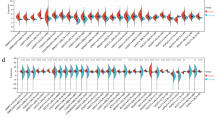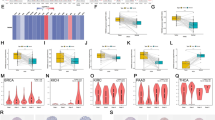Abstract
Polycomb repressive complex 2 (PRC2; formed by EZH2, SUZ12, and EED protein subunits) and PRC1 (BMI1 protein) induce gene silencing through histone modification, primarily H3K27me3, and deregulation of PRC pathways leads to tumorigenesis. In the present study, activation of PRC2, H3K27me3, and BMI1 was investigated by immunohistochemistry in 175 cases of T and natural killer (NK) cell lymphoma. Activation of PRC proteins was analyzed according to c-MYC activation, Epstein-Barr virus (EBV) infection, CD30 activation, and survival. Among all T and NK cell lymphomas, high expression rates of 54.7 % for EZH2, 33.3 % for SUZ12, 85.7 % for EED, 40.5 % for H3K27me3, and 30.9 % for BMI1 were discovered. Activation of PRC2, H3K27me3, and BMI1 showed positive correlations (P < 0.05). Activation of c-MYC was associated with activation of SUZ12 and triple coactivation of all PRC2 protein subunits (EZH2high/SUZ12high/EEDhigh) (P < 0.05). In EBV-positive tumors, activation of EZH2 and H3K27me3 showed greater association (P < 0.05). H3K27me3 and BMI1 showed a negative association in tumors expressing CD30 (P < 0.05). With respect to survival, BMI1 activation was independently associated with poor prognosis in T and NK cell lymphomas (P = 0.002). In conclusion, T and NK cell lymphomas were associated with activation of PRC pathway markers, for which c-MYC activation and EBV infection could be suggested as possible causes. PRC pathway markers may be potential therapeutic targets and prognostic markers in T and NK cell lymphoma.





Similar content being viewed by others
References
Hassler MR, Schiefer AI, Egger G (2013) Combating the epigenome: epigenetic drugs against non-Hodgkin's lymphoma. Epigenomics 5:397–415
Marquard L, Poulsen CB, Gjerdrum LM et al (2009) Histone deacetylase 1, 2, 6 and acetylated histone H4 in Band T-cell lymphomas. Histopathology 54:688–98
Couronne L, Bastard C, Bernard OA (2012) TET2 and DNMT3A mutations in human T-cell lymphoma. N Engl J Med 366:95–6
Satijn DP, Otte AP (1999) Polycomb group protein complexes: do different complexes regulate distinct target genes? Biochim Biophys Acta 1447:1–16
Lin YW, Chen HM, Fang JY (2011) Gene silencing by the Polycomb group proteins and associations with cancer. Cancer Investig 29:187–95
Morey L, Helin K (2010) Polycomb group protein-mediated repression of transcription. Trends Biochem Sci 35:323–32
Kim SH, Singh SV (2015) The role of polycomb group protein Bmi-1 and Notch4 in breast cancer stem cell inhibition by benzyl isothiocyanate. Breast Cancer Res Treat 149:681–92
Oh EJ, Yang WI, Cheong JW et al (2014) Diffuse large B-cell lymphoma with histone H3 trimethylation at lysine 27: another poor prognostic phenotype independent of c-Myc/Bcl2 coexpression. Hum Pathol 45:2043–50
Benard A, Goossens-Beumer IJ, van Hoesel AQ et al (2014) Prognostic value of polycomb proteins EZH2, BMI1 and SUZ12 and histone modification H3K27me3 in colorectal cancer. PLoS One 9:e108265
Abd El hafez A, El-Hadaad HA (2014) Immunohistochemical expression and prognostic relevance of Bmi-1, a stem cell factor, in epithelial ovarian cancer. Ann Diagn Pathol 18:58–62
Abd Al Kader L, Oka T, Takata K et al (2013) In aggressive variants of non-Hodgkin lymphomas, Ezh2 is strongly expressed and polycomb repressive complex PRC1.4 dominates over PRC1.2. Virchows Arch 463:697–711
Lee H, Yoon SO, Jeong WY et al (2012) Immunohistochemical analysis of polycomb group protein expression in advanced gastric cancer. Hum Pathol 43:1704–10
Morin RD, Johnson NA, Severson TM et al (2010) Somatic mutations altering EZH2 (Tyr641) in follicular and diffuse large B-cell lymphomas of germinal-center origin. Nat Genet 42:181–5
van Galen JC, Muris JJ, Oudejans JJ et al (2007) Expression of the polycomb-group gene BMI1 is related to an unfavourable prognosis in primary nodal DLBCL. J Clin Pathol 60:167–72
Vizan P, Beringer M, Ballare C et al (2015) Role of PRC2-associated factors in stem cells and disease. FEBS J 282:1723–35
Cao R, Wang L, Wang H et al (2002) Role of histone H3 lysine 27 methylation in Polycomb-group silencing. Science 298:1039–43
Martin-Perez D, Piris MA, Sanchez-Beato M (2010) Polycomb proteins in hematologic malignancies. Blood 116:5465–75
Dutton A, Woodman CB, Chukwuma MB et al (2007) Bmi-1 is induced by the Epstein-Barr virus oncogene LMP1 and regulates the expression of viral target genes in Hodgkin lymphoma cells. Blood 109:2597–603
Raaphorst FM (2005) Deregulated expression of Polycomb-group oncogenes in human malignant lymphomas and epithelial tumors. Hum Mol Genet 14(Spec No 1):R93–100
Sanchez-Beato M, Sanchez E, Garcia JF et al (2004) Abnormal PcG protein expression in Hodgkin's lymphoma. Relation with E2F6 and NFkappaB transcription factors. J Pathol 204:528–37
van Kemenade FJ, Raaphorst FM, Blokzijl T et al (2001) Coexpression of BMI-1 and EZH2 polycomb-group proteins is associated with cycling cells and degree of malignancy in B-cell non-Hodgkin lymphoma. Blood 97:3896–901
Swerdlow SH. International Agency for Research on C, World Health O. WHO classification of tumours of haematopoietic and lymphoid tissues. International Agency for Research on Cancer: Lyon, France; 2008.
Vogel UF, Bueltmann BD (2006) Simple, inexpensive, and precise paraffin tissue microarrays constructed with a conventional microcompound table and a drill grinder. Am J Clin Pathol 126:342–8
Lee C, Park JW, Suh JH et al (2013) ALK-positive renal cell carcinoma in a large series of consecutively resected Korean renal cell carcinoma patients. Korean J Pathol 47:452–7
Benetatos L, Vartholomatos G, Hatzimichael E (2014) Polycomb group proteins and MYC: the cancer connection. Cell Mol Life Sci 71:257–69
Sander S, Bullinger L, Klapproth K et al (2008) MYC stimulates EZH2 expression by repression of its negative regulator miR-26a. Blood 112:4202–12
Jacobs JJ, Scheijen B, Voncken JW et al (1999) Bmi-1 collaborates with c-Myc in tumorigenesis by inhibiting c- Myc-induced apoptosis via INK4a/ARF. Genes Dev 13:2678–90
Kaur M, Cole MD (2013) MYC acts via the PTEN tumor suppressor to elicit autoregulation and genome-wide gene repression by activation of the Ezh2 methyltransferase. Cancer Res 73:695–705
Krepelova A, Neri F, Maldotti M et al (2014) Myc and max genome-wide binding sites analysis links the Myc regulatory network with the polycomb and the core pluripotency networks in mouse embryonic stem cells. PLoS One 9:e88933
Neri F, Zippo A, Krepelova A et al (2012) Myc regulates the transcription of the PRC2 gene to control the expression of developmental genes in embryonic stem cells. Mol Cell Biol 32:840–51
Yamaguchi H, Hung MC (2014) Regulation and role of EZH2 in cancer. Cancer Res Treat 46:209–22
Allday MJ (2013) EBV finds a polycomb-mediated, epigenetic solution to the problem of oncogenic stress responses triggered by infection. Front Genet 4:212
Schwab U, Stein H, Gerdes J et al (1982) Production of a monoclonal antibody specific for Hodgkin and Sternberg-Reed cells of Hodgkin's disease and a subset of normal lymphoid cells. Nature 299:65–7
Stein H, Mason DY, Gerdes J et al (1985) The expression of the Hodgkin's disease associated antigen Ki-1 in reactive and neoplastic lymphoid tissue: evidence that Reed-Sternberg cells and histiocytic malignancies are derived from activated lymphoid cells. Blood 66:848–58
Valent P, Sotlar K, Horny HP (2011) Aberrant expression of CD30 in aggressive systemic mastocytosis and mast cell leukemia: a differential diagnosis to consider in aggressive hematopoietic CD30-positive neoplasms. Leuk Lymphoma 52:740–4
Deutsch YE, Tadmor T, Podack ER et al (2011) CD30: an important new target in hematologic malignancies. Leuk Lymphoma 52:1641–54
Saudy NS, Fawzy IM, Azmy E et al (2014) BMI1 gene expression in myeloid leukemias and its impact on prognosis. Blood Cells Mol Dis 53:194–8
Acknowledgments
This work was supported by grant no. 2014–01 from the Korean Medical Women’s Association.
Conflicts of interest
None.
Author information
Authors and Affiliations
Corresponding author
Electronic supplementary material
Rights and permissions
About this article
Cite this article
Kim, S.H., Yang, W.I., Min, Y.H. et al. The role of the polycomb repressive complex pathway in T and NK cell lymphoma: biological and prognostic implications. Tumor Biol. 37, 2037–2047 (2016). https://doi.org/10.1007/s13277-015-3977-y
Received:
Accepted:
Published:
Issue Date:
DOI: https://doi.org/10.1007/s13277-015-3977-y




